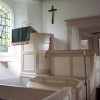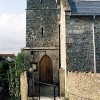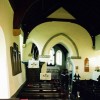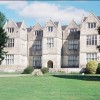Most people will have heard of the famous voyage of the Mayflower, the gallant little ship bearing 102 Puritans fleeing religious persecution, which sailed to the New World from Plymouth in 1620. Just eight years later another little ship sailed from Weymouth, following the lead that the Mayflower had set. That ship, called Abigail, was conveying many Dorset emigrants to the colony of New England. The Abigail was under the mastership of Henry Gauden, but also aboard was the man on his way to become the plantation’s Governor. His name was John Endicott.
Beside Weymouth’s Harbour today there stands a double memorial to Endicott and Richard Clark, a pilot captain from the town involved in the pioneer discovery of Newfoundland. Originally set up by the Pavilion (The Ritz) on 2nd June 1914, the memorial was relocated to Alexandra Gardens after the Pavilion was gutted by fire in 1954. The original unveiling in 1914 was undertaken by Mrs Joseph Chamberlain, a direct descendant of John Endicott. In 1999 an appeal to raise funds for moving the monument to its present site beside the harbour was launched by Weymouth Civic Society. The lower of the two inscriptions is dedicated to Endicott and reads: “John Endicott, who on June 20th 1628 set forth from Weymouth in the ship “Abigail” on the expedition which led to the establishment of the plantation at Salem, Massachusetts.”
John Endicott (sometimes alternatively spelt Endecott) was born in 1558, but there are few or no records relating to his early life. Although he is recorded as having been born in Dorchester, there is also a tradition that he was born in Chagford, a small town on the eats flank of Dartmoor, since here there exists a building bearing his name. Certainly it is known he was a member of the Dorchester Company of the Revd. John White and became one of its six patentees. By means of a purchase of 1627 the company succeeded to the property, rights and privileges formerly belonging to the Plymouth Company. Soon after, Matthew Cradock and Roger Ludlow secured the proprietor rights and became respectively Governor and Deputy Governor at the Company’s headquarters in London. By virtue of being related to both men by marriage, Endicott was assigned the task of taking charge of the colonial plantation at Naumkeag, as Salem was first known, and to develop its potential. In the embryonic colonial world of the early 17th century there were several semi-independent colonies ensconced in what is today southern New England, and each under the control of its own leader.
He duly arrived in New England with his family and sixty men aboard the Abigail in September 1628. The colonists were settling land previously administered by Robert Conant, who had left the Plymouth colony two years before. Endicott was the chief authority, magistrate, soldier and governor in the colony for the next two years until the charter and company were transferred to New England and John Winthrop arrived to take charge in April 1630. In 1634, while a member of the court of assistants, Endicott, angered by a fiery sermon delivered by Roger Williams, had the red cross of St. George struck from the King’s colours hanging before the governor’s gate. The governor evidently deemed the cross to be an idolatrous emblem redolent of popery, but the action brought upon him a stinging reprimand and dismissal from his post.
Despite his sacking from the Governorship, Endicott continued to serve in several important positions. But Endicott was not without his supporters and sympathisers, principally among the militia. Some even refused to march beneath a flag that bore the George cross. After some controversy, the military commissioners agreed that the cross should only be retained on the banners or ships and forts. In association with Captain John Underhill, Endicott undertook an ineffectual expedition against Block Island and the native Pequot tribe in 1636. But his move against the Indians was extremely harsh and punitive, such that the tribe’s reaction sparked the Pequot War. The combatants in this war however were represented by different leaders with different interests.
John Endicott served several terms as Governor: in 1641, 1644, 1649, then from 1650 until 1665 with the exception of 1654. In addition, in 1645 he was awarded the highest military office in the colony; that of sergeant major general and subsequently became president of the colonial commissioners in 1658. At times he was Commander-in-Chief of the militia and served as Commissioner and President of the United Colonies of New England.
It was entirely typical of Endicott’s business-like acumen that he should early establish a mint in the fledgling colony to meet the fiscal requirements of the time. However, the works contravened a law by continuing to mint coinage for thirty years. Despite his professionalism, like all men, he had his faults. One of these was some would consider an intense religious bigotry and fanaticism in the line of Puritanism, such that he could not endure the least breach or deviation from what he considered the straight line of orthodoxy. He distained episcopacy as much as popery, as some of the prelatic clergy found to their cost, though rather out of character he defended the stance of Roger Williams, who had earlier inflamed the governor with his controversial sermon. Even the Quakers were not above his condemnation, and under Endicott’s administration four of these gentle pacifists were executed at Boston for alleged flouting of the laws. His other unpleasant trait was a quick temper, which on one occasion early in his administration brought upon him a fine of forty shillings for striking another man.
On a more positive note, Endicott was said to be a man of dauntless courage and “a fit instrument to begin the wilderness work.” His was a rugged nature which the strictness of his nonconformity never mellowed, though he could be cheerful and benevolent. He also aimed for the good of the colony and always sought to ensure that its welfare was a priority.
He died in 1665.



